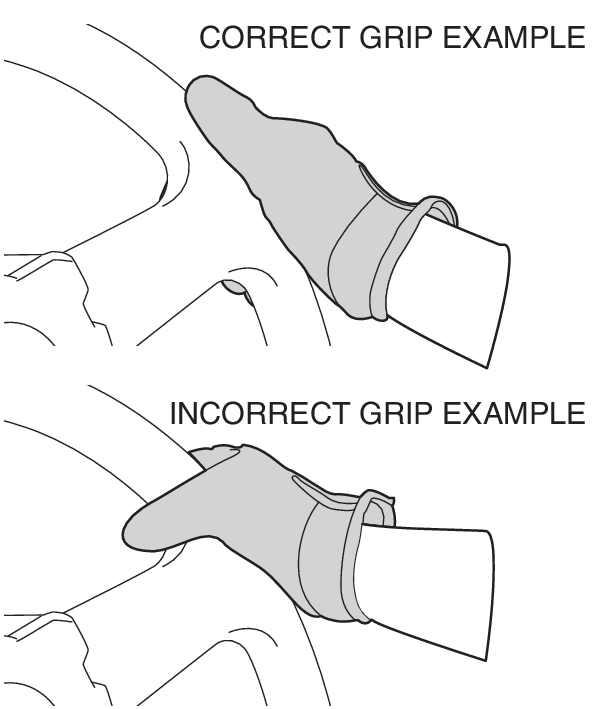KNOW YOUR VEHICLE
This off-road vehicle will handle and maneuver differently from cars, ATVs, go-carts, golf-cars and grounds-keeping vehicles. The Wolverine RMAX4 has higher ground clearance and other features to handle rugged terrain, and, as a result, can overturn in situations where some vehicles may not. This would include vehicles made primarily for pavement, roads, improved paths, or grounds-keeping. If you do not use care in maneuvering the Wolverine RMAX4, you can cause it to roll over even on flat, open areas.
Doing things with a Wolverine RMAX4 that some people do for thrills in other vehicles [such as sideways sliding, skidding, fishtailing (rear-wheel sliding), or donuts] have led to side rollovers. These rollovers can result in crushed limbs and other serious injuries or death to drivers or passengers.
As the owner/operator, it is your responsibility to protect yourself and your passengers from accidents, including rollovers. The Wolverine RMAX4 has many features, including a protective structure and seat belts, to help protect occupants, but the best way to avoid injuries is to avoid accidents. There is a risk of injury or death in any accident, even with these safety features.
Driver requirements
- This vehicle is intended for use only by an operator 16 or older with a valid motor vehicle license. Check local laws for minimum age requirements.
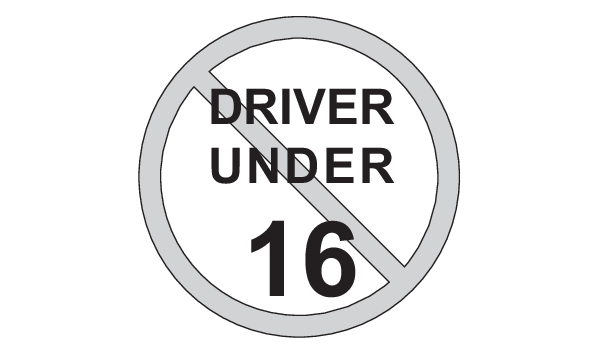
- The driver must be able to place both feet flat on the floorboard while seated upright with his/her back against the backrest.
- Do not drive after using drugs or alcohol.
- Remove the ignition key when the vehicle is not in use to prevent unauthorized use of the machine.
Parents:
Many countries or states have implemented new motor vehicle licensing requirements for young drivers. These requirements are in response to the disproportionately high rate of crashes involving youthful drivers. As with automobiles, to promote safe driving behaviors, you should supervise younger drivers and consider setting rules and putting limits on how, when, and where the Wolverine RMAX4 can be used.
Passenger requirements
This vehicle is designed for the operator and three passengers. Allowing passengers to ride improperly can lead to serious injury or death. As the operator, you are responsible for your passengers.
- Your passengers must be able to place both feet on the floorboard while seated upright with their backs against the backrests.
- Your passengers must be able to reach and hold the passenger handhold.
- Allow only three passengers in the vehicle and only in the designated passenger seats. Do not carry any other passengers. Do not carry passengers in the cargo bed.
- Do not allow someone to ride as a passenger who has been using drugs or alcohol.
- Do not allow children who need child safety seats or booster seats in the Wolverine RMAX4. The seat belt is not designed to restrain automotive child safety seats.
Occupant protection system
Do not make changes to the occupant protection system. If you install aftermarket products or have your vehicle modified, you may put yourself and others at greater risk of serious injury or death. You are responsible for any such changes to the vehicle.
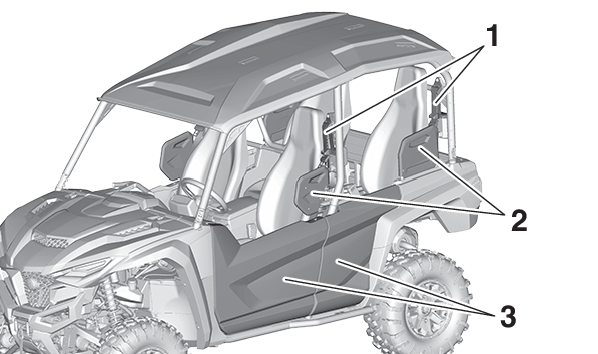
- Seat belt
- Shoulder bolster
- Door
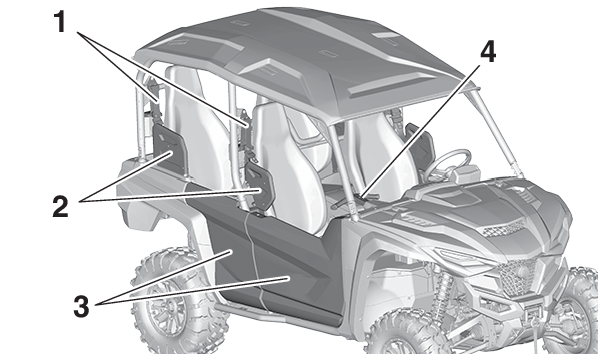
- Seat belt
- Shoulder bolster
- Door
- Front passenger handhold
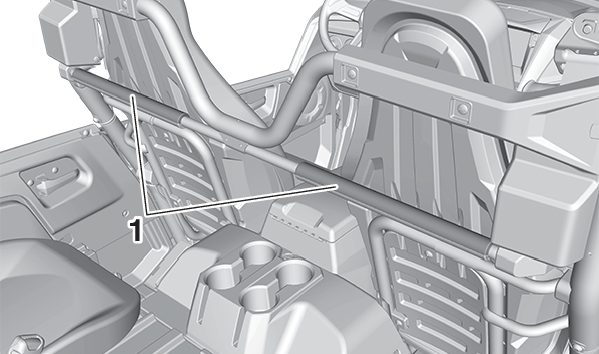
- Rear passenger handhold
The Wolverine RMAX4 comes with a variety of features to help reduce the risk of driver and passenger injury. These features work together, and when properly used, these features will help protect the occupants in the event of an accident. If these features are not used properly, they can cause injury.
Protective structure
The vehicle cage/frame provides a protective structure that helps limit intrusions by branches or other objects and may reduce your risk of injury in accidents. The protective structure will not protect occupants in all rollovers or accidents.
Body parts outside of vehicle can be struck by passing objects or crushed during vehicle rollover. Do not put your hands or feet outside of the vehicle for any reason. Do not hold onto the door, cage/frame or shoulder bolster. Wear your seat belt and helmet.
If you think or feel that the vehicle may tip or roll, do not put your hands or feet outside the vehicle for any reason. You will not be able to stop the vehicle from tipping over using your body. Any part of your body (arms, legs, or head) outside of the vehicle can be crushed by the vehicle cage/frame.
Seat belts
Seat belts should be worn by the driver and passengers. The driver must be sure that the passengers are belted before driving.
- Be sure that each occupant’s seat belt latch plate is inserted into the appropriate buckle.
- Be sure the seat belt is not twisted, is close-fitting across the hips and chest, and is latched securely.
- Do not wear the seat belt across the abdomen or stomach.
- Do not put the seat belt behind the back.
Failure to use seat belts properly may lead to an increased likelihood and severity of injury.
An unbelted occupant may strike the interior of the vehicle, the protective structure, or other objects in an accident or during operation. You may also fall completely out or be partially ejected from the vehicle, which may lead to being crushed between the ground and the vehicle. Wearing the seat belt helps you remain in the vehicle – the doors and passenger handhold are not a substitute for using a seat belt.
A crash can damage the restraint systems in your vehicle. A damaged restraint system may not properly protect the person using it, resulting in serious injury or death in a crash. To help make sure your restraint systems are working properly after a crash, have them inspected and any necessary replacements made as soon as possible.
Front seat belts
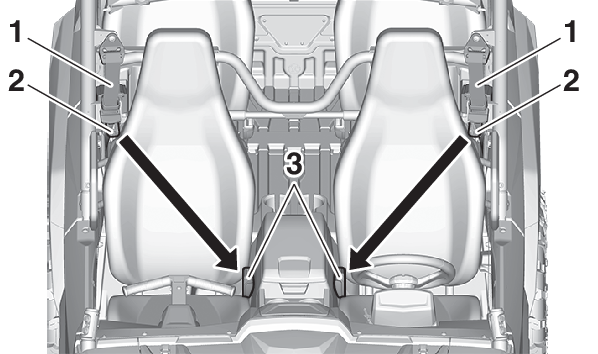
- Seat belt
- Latch plate
- Buckle
Rear seat belts
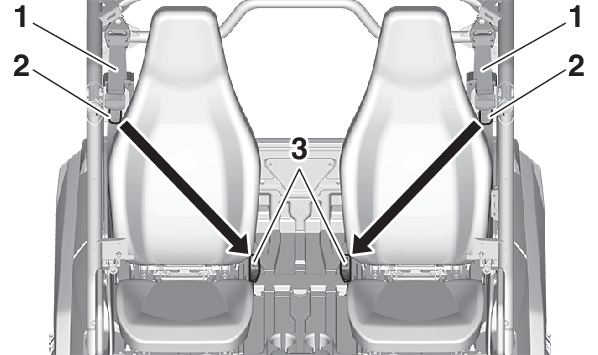
- Seat belt
- Latch plate
- Buckle
To wear the seat belt properly, do the following:
Hold the latch plate as you pull the belt across your lap and chest. Make sure the belt is not twisted and is not caught on any portion of the vehicle, your clothing, or any equipment you are carrying.
If the latch plate is not positioned in the correct location along the seat belt, adjust its location up or down along the length of the belt.
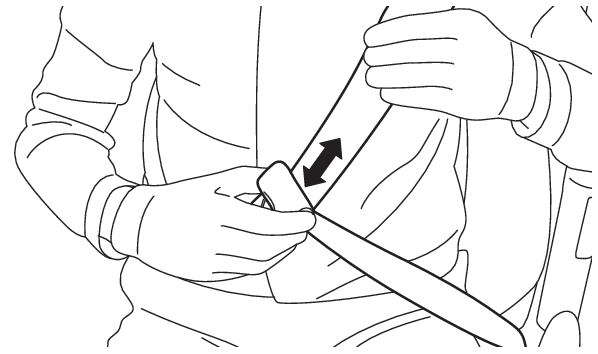
Push the latch plate into the buckle until it clicks. Pull up on the latch plate to make sure it is secure.
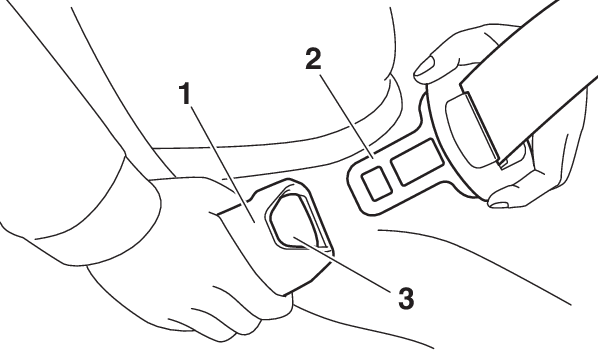
- Buckle
- Latch plate
- Release button
Put the lap portion of the belt low on your hips. Pull up on the shoulder part so the belt is snug across your hips. Be sure the seat belt is not caught on the shoulder bolster or other object.
Position the shoulder belt over your shoulder and across your chest. The shoulder belt should fit against your chest. If it is loose, pull the belt out all the way and then let it retract.
Check if the seat belt shoulder position suits the size of the driver and passengers.
To adjust the seat belt shoulder position, move the seat belt height adjuster left and right while pulling it toward the front of the vehicle, and slide it up and down.
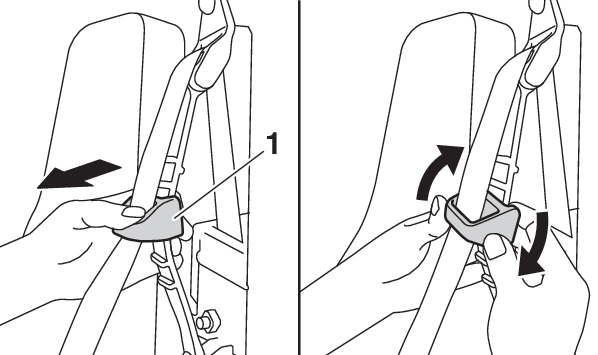
- Seat belt height adjuster
To release the buckle, firmly press the release button.
Doors
The doors are designed to reduce the likelihood that you will stick your leg out to stop the vehicle from tipping over or for any other reason in a rollover. The doors may also reduce intrusion of objects into the occupant area. Make sure the door is securely latched before operation. Do not place your arm or hand on the door during operation. Your hand or arm may be struck by objects or crushed against outside objects or the ground during a rollover.
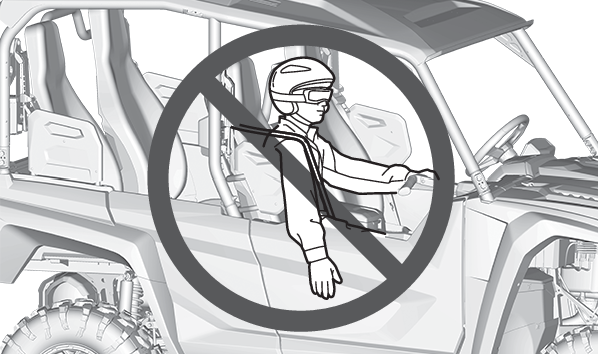
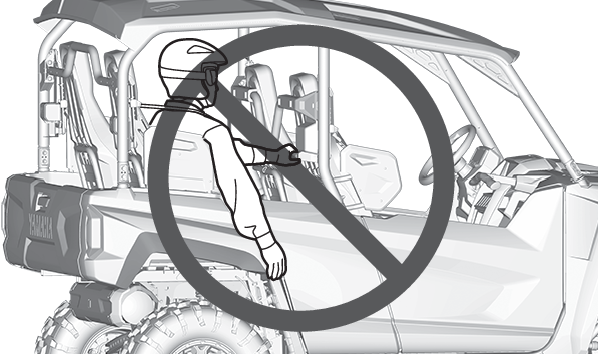
Passenger handhold
The passenger handhold is provided to grip during operation to maintain proper position and balance. Holding onto the handhold helps to reduce the likelihood that the passengers put a hand outside the vehicle if the vehicle begins to tip.
The driver should make sure the passengers are holding onto the handhold with both hands before operating the vehicle.
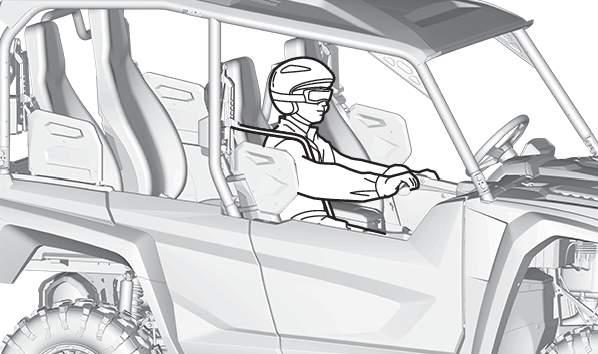
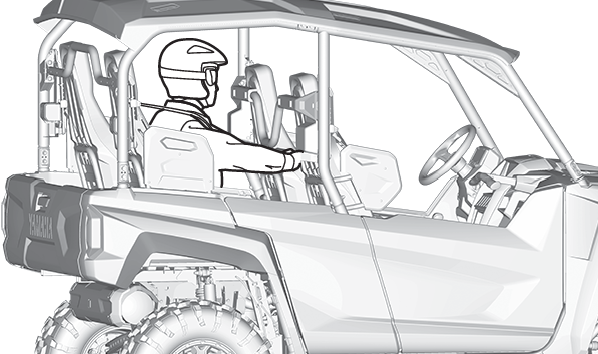
Adjusting the front passenger handhold position
The front passenger handhold can be adjusted to suit the passenger’s preference.
To adjust the handhold position, push the lever and slide the handhold to desired position. Make sure that the handhold is properly secured before starting off.
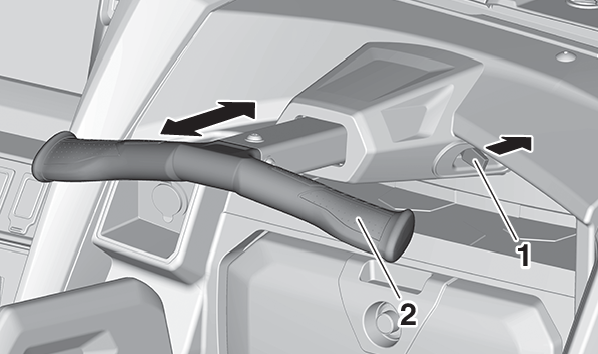
- Lever
- Front passenger handhold
Seat and shoulder bolsters
The seats and shoulder bolsters are designed to help keep you in the vehicle. Do not put your hand or arm on or outside of the shoulder bolster during operation. Your hand or arm may be struck by objects or crushed against outside objects or the ground during a rollover.
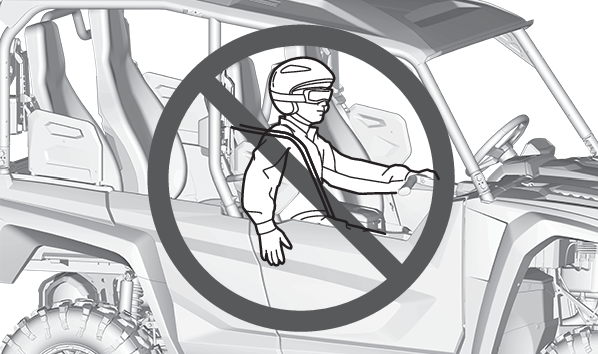
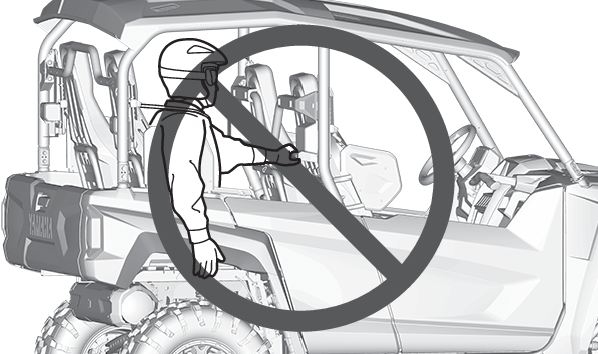
Floorboard
The floorboard allows you to brace your feet, which helps you keep your body in the vehicle in the event of an accident or rollover. Keep your feet on the floorboard during operation.
Steering wheel
Keep both hands on the steering wheel. Do not hold the steering wheel with your thumbs inside the rim. Keep your palms on the outside of the steering wheel. Similar to other off-road vehicles, if the Wolverine RMAX4 hits a deep rut or large obstacle, the steering wheel could briefly jerk in one direction or back and forth as the tires and vehicle respond to the obstacle. This quick motion could injure your thumbs or wrist if your thumbs or hand(s) are inside the steering wheel. Grip the steering wheel so that your thumbs will not be hit by the spokes. As an example, see the illustration.
